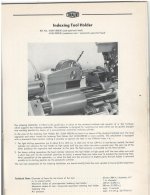EPAIII
Diamond
- Joined
- Nov 23, 2003
- Location
- Beaumont, TX, USA
There are many ways to cut identical lengths. Basically a saw with a stop. If you need tighter tolerances, then you will have to finish it in the lathe or some other machine (mill?).
I had to make a bunch of 1/4" diameter, aluminum pins with nice ends: flat, square, and with a chamfer. I found this:

It is a hand tool, but I see no reason why you could not make or buy a version for use under power. It is one tool that does internal and external chamfers using the two sides.
I also made this from a center cutting, end mill and a scrap of steel.

It works just great in a hand held drill: just put the pin (your tube) in a vise and hit it for a second or two. For larger diameter tubes I think abrasive disks would be better than the milling cutter. That would probably need a two piece holder with the abrasive disk between them. They would be held together with screws or a male/female thread cut on the two halves.
You could have two or three shop made tools mounted in hand held drills: facing, outside chamfer, and inside chamfer. Slap the cut tube in a vise and use the shop made tools in rapid succession. Flip the tube around and do the other side. Should go quickly.
I had to make a bunch of 1/4" diameter, aluminum pins with nice ends: flat, square, and with a chamfer. I found this:
It is a hand tool, but I see no reason why you could not make or buy a version for use under power. It is one tool that does internal and external chamfers using the two sides.
I also made this from a center cutting, end mill and a scrap of steel.
It works just great in a hand held drill: just put the pin (your tube) in a vise and hit it for a second or two. For larger diameter tubes I think abrasive disks would be better than the milling cutter. That would probably need a two piece holder with the abrasive disk between them. They would be held together with screws or a male/female thread cut on the two halves.
You could have two or three shop made tools mounted in hand held drills: facing, outside chamfer, and inside chamfer. Slap the cut tube in a vise and use the shop made tools in rapid succession. Flip the tube around and do the other side. Should go quickly.





